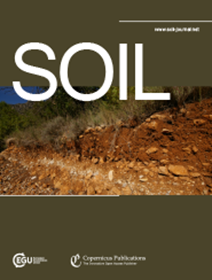Soil carbon accrual and biopore formation across a plant diversity gradient
IF 5.8
2区 农林科学
Q1 SOIL SCIENCE
引用次数: 0
Abstract
Abstract. Plant diversity promotes soil organic carbon (SOC) gains through intricate changes in root-soil interactions and their subsequent influence on soil physical and biological processes. We assessed SOC and pore characteristics of soils under a range of switchgrass-based plant systems, representing a gradient of plant diversity with species richness ranging from 1 to 30 species 12 years after their establishment. We focused on soil biopores as indicators of root activity legacy, measured using X-ray computed micro-tomography scanning, and explored biopore relationships with SOC accumulation. Plant functional richness explained 29 % of bioporosity and 36 % of SOC variation, while bioporosity itself explained 36 % of the variation in SOC. The most diverse plant system (30 species) had the highest SOC, while long-term bare soil fallow and monoculture switchgrass had the lowest. Of particular note was a two-species mixture of switchgrass (Panicum virgatum L.) and ryegrass (Elymus canadensis), which exhibited the highest bioporosity and achieved SOC levels comparable to those of the systems with 6 and 10 plant species, and were inferior only to the system with 30 species. We conclude that plant diversity may enhance SOC through biopore-mediated mechanisms and suggest a potential for identifying specific plant combinations that may be particularly efficient for fostering biopore formation and subsequently SOC sequestration.植物多样性梯度下土壤碳积累与生物孔形成
摘要。植物多样性通过根-土相互作用的复杂变化及其对土壤物理和生物过程的影响促进土壤有机碳(SOC)的增加。我们评估了一系列柳枝稷植物系统下土壤的有机碳和孔隙特征,它们代表了植物多样性的梯度,物种丰富度在1到30种之间。我们将土壤生物孔作为根系活动遗留的指标,利用x射线计算机微断层扫描进行测量,并探讨了生物孔与有机碳积累的关系。植物功能丰富度解释了29%的生物多样性和36%的有机碳变化,而生物多样性本身解释了36%的有机碳变化。最多样化的植物系统(30种)的有机碳含量最高,而长期裸地休耕和单一柳枝稷的有机碳含量最低。柳枝稷(Panicum virgatum L.)和黑麦草(Elymus canadensis)的两种混交种表现出最高的生物多样性,其有机碳水平与6种和10种植物的系统相当,仅低于30种植物的系统。我们得出的结论是,植物多样性可能通过生物孔介导的机制增强有机碳,并提出了鉴定特定植物组合的潜力,这些组合可能特别有效地促进生物孔的形成和随后的有机碳封存。
本文章由计算机程序翻译,如有差异,请以英文原文为准。
求助全文
约1分钟内获得全文
求助全文
来源期刊

Soil
Agricultural and Biological Sciences-Soil Science
CiteScore
10.80
自引率
2.90%
发文量
44
审稿时长
30 weeks
期刊介绍:
SOIL is an international scientific journal dedicated to the publication and discussion of high-quality research in the field of soil system sciences.
SOIL is at the interface between the atmosphere, lithosphere, hydrosphere, and biosphere. SOIL publishes scientific research that contributes to understanding the soil system and its interaction with humans and the entire Earth system. The scope of the journal includes all topics that fall within the study of soil science as a discipline, with an emphasis on studies that integrate soil science with other sciences (hydrology, agronomy, socio-economics, health sciences, atmospheric sciences, etc.).
 求助内容:
求助内容: 应助结果提醒方式:
应助结果提醒方式:


